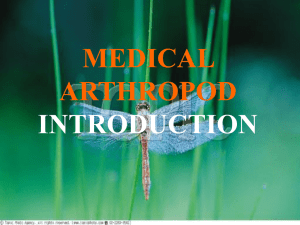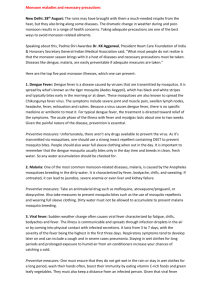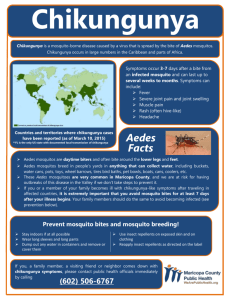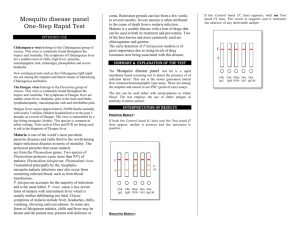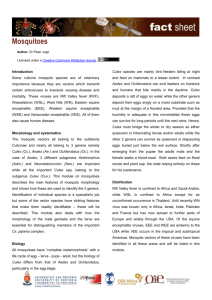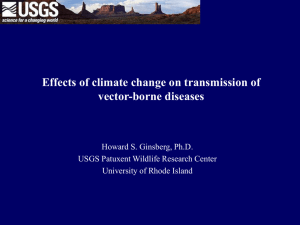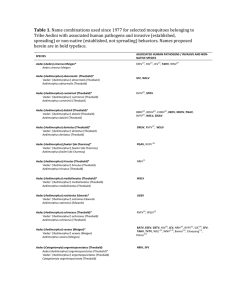MOSQUITOES
advertisement
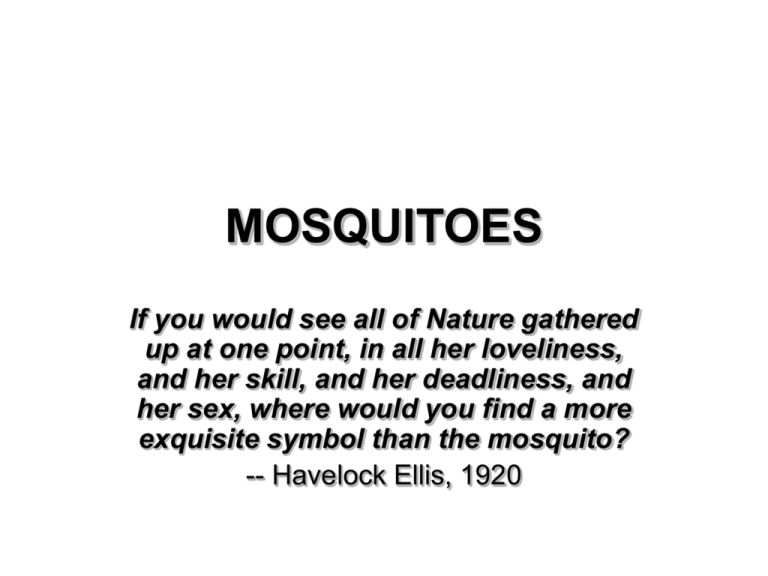
MOSQUITOES If you would see all of Nature gathered up at one point, in all her loveliness, and her skill, and her deadliness, and her sex, where would you find a more exquisite symbol than the mosquito? -- Havelock Ellis, 1920 HISTORY • • • • • • • • Ancient Rome Scotland Middle ages and Henry II Ancient India and Mesopotamia Ancient China Egypt Alexander the Great 323 B.C. Genghis Khan and Western Europe Alexander The Great • General, King, Ruler • Babylon 323 B.C. • Malaria? • WNV? • Typhoid? European Exploration • European exploration of new lands. • Defensive and Offensive diseases. • Offensive germs in the New World. • Indigenous destruction • Slave trade • 1890’s and beyond… The Family Culicidae - Mosquitoes • Worldwide distribution • > 3450 species and subspecies (38 genera) • Great habitat diversity • Approximately 40 million years older than humans (fossils from Eocene, 38-54 mya) • Anophelinae (subfamily) - Anopheles (genus) • Culicinae (subfamily) - Aedes, Culex, Haemagogus, Mansonia, Ochlerotatus and all other genera Mosquito Characteristics • Conspicuous proboscis - forward projecting • Scales on thorax, abdomen, legs & wing veins • A fringe of scales along the posterior margin of the wings Mosquito Characteristics (note conspicuous forward projecting proboscis) Non-biting Gnat (note proboscis curved under head) Gnat Mosquito Mosquito Characteristics • Bloodfeeding - only females take blood • Males and females feed on plant sugars • Gonotrophic cycle - feed, egg development, oviposition (half-gravid, gravid) • Egg biology - oviposition location, type of egg, desiccation resistance, diapause • Larval biology - aquatic, spiracle for breathing, filter-feeders, some cannibalistic, variable habitats (1) Eggs – 3 strategies • Singly on water surface – Anopheles • Singly in a pile, on moist substrates – Aedes/Ochlerotatus • Form of a raft, on water surface – Culex – Culiseta Mosquito eggs: Culex egg raft Anopheles egg with ‘floats’ Aedes egg Patterns on the external egg surface are species specific Egg stage comparison CULEX Egg Raft (2) Embryonation – 2 options • Eggs hatch immediately (not all) • OR • Diapause required – Triggered by decreasing day length. • **Egg stage over wintering stage** – Aedes/Ochlerotatus (3) Larval Stage – Growth Stage • Larval instars (4) • Aquatic, Filter feeders • Respiration Anopheles (4) Pupa – Lighter than water • Non-feeding • Respiration Pupal Stage Comparison Anopheline Culicine Mosquito Pupa and Larvae Anopheles Pupa and Larvae Mosquito Emerging from Pupal Exuvia (5) Adults • Emergence • Mating • Feeding Adult Stage Comparison Anopheline Culicine females Culicine Anopheline males Comparison of male and female Anophelines vs. Culicines Behavior • Activity • Host Specificity – Zoophilous – Anthropophilous – Ornithophilous HABITAT Medical Importance • Biting Nuisance (annoyance) • Arboviruses – Numerous (Yellow Fever, Dengue Fever, WNV, JE, SLE, EEE, WEE, VEE). • Filariasis – Bancroftian and Brugian filariasis. • Malaria – 4 plasmodium species Malaria History • Ronald Ross (1897) • Malaria Eradication? • Between 350 and 500 million clinical episodes of malaria occur every year. • 1-2 million deaths occur every year. • About 60% of the cases of malaria worldwide and more than 80% of the malaria deaths worldwide occur in Africa south of the Sahara. HUMAN MALARIA • Parasite – Plasmodium spp. – P. falciparum, P. vivax, P. malaria, P. ovale • Vector – Anopheles spp. • Host • Reservoir • Distribution Anopheles gambiae WHO/TDR/HOLT Studios, 1992 Global Distribution Distribution • Distribution Model Distribution • Endemic / Epidemic Risk Areas Distribution • Duration of Malaria Transmission Season. • Distribution Start / End of Transmission Season Distribution • Population Distribution Filariasis History • • • • Patrick Manson (1877) Worked in Taiwan Autopsies in China Threadlike worms • “Nothing walks with aimless feet.:” Mosquito-Borne Human Filariasis • 250 million infections each year • 2-3 million cases of obstructive filariasis • 20% of pop in Calcutta infected • 2 diseases that affect humans – Urban Disease – Rural Disease Urban and Rural Disease • Urban Disease (Bancroftian filariasis) – Parasite – – An anthroponosis – Bancroftia • Rural Disease (Brugian filariasis) – Parasite – – An anthroponosis or zoonosis – Brugian Transmission • (1) Microfilariae in blood. • (2) • (3) Microfil. Penetrate midgut thoracic muscles. • (4) • (5) Enter new host. Periodicity • (1) Periodic Infection • (2) Subperiodic Infection VECTORS • (1) Bancroftian Filariasis – – – – Cx. pipiens quinquefasciatis Cx. pipiens pipiens Anopheles spp. Aedes spp. • (2) Brugian Filariasis – Anopheles spp. – Aedes spp. – Mansonia (genus) DISTRIBUTION • Tropics and subtropics • Wuchereria bancrofti is encountered in _________________. • Brugia malayi is limited to _____. • Dog Heartworm (Dirofilaria immitis, D. repens) Mosquito Arboviruses • Intrinsic incubation period of a virus in humans is a few days. • Host becomes viraemic. • Viraemia lasts typically 3 days then disappears from the peripheral blood. • An arthropod must bite a viraemic host if it is to become infected. Yellow Fever History Yellow Fever • • • • • • • • Brought to U.S. via slave trade. Aedes aegypti Originally in New World Monkey populations Jungle Yellow fever (3-factor disease in monkeys) New World people bring to town Old World mooting monkeys bring to town. Does occasionally occur in U.S. 1964 Eradication program (U.S. Public Health) YELLOW FEVER • Is a _______ • Prevented the building of the Panama Canal. • Pathogen: • Vector: Aedes aegypti, Aedes spp., Haemagogus • Host: Reservoir • Human-mosquito in urban cycle, • Monkey-mosquito in forest cycle; • Deforestation may force infected monkeys into areas where human-mosquito transmission can occur. African Yellow Fever Transmission Cycle Vectors: • Ae. Africanus (sylvatic) • Ae. Bromeliae (rural) • Ae. Aegypti (urban) • Transovarial Transmission Central and South America Yellow Fever Transmission Cycle Vectors: • Haemagogus spp. (jungle) • Haemagogus spp. (rural) • Ae. Aegypti (urban) • Transovarial Transmission Distribution Diagnosis and Symptoms • Most infections are mild, but the disease can cause severe, life-threatening illness. • Symptoms of severe infection are high fever, chills, headache, muscle aches, vomiting, and backache. After a brief recovery period, the infection can lead to shock, bleeding, and kidney and liver failure. Liver failure causes jaundice (yellowing of the skin and the whites of the eyes). • Diagnosed by blood test. Prevention and Treatment • General precautions to avoid mosquito bites; the use of insect repellent, protective clothing, and mosquito netting. • Yellow fever vaccine has been used for several decades. A single dose has a lasting immunity of 10 years or more. (Live virus vaccine) • Booster dose is given every 10 years as needed. • Treatment: No real treatment, drink plenty of fluids, keep away from mosquitoes to protect others, most people get better over a long recovery period. Dengue Fever History Dengue (Breakbone) Fever • Dengue has four serological types (DEN-1,DEN-2,DEN-3 and DEN-4). • Pathogen: • • Host: • Reservoir: VECTORS • Aedes aegypti (Yellow fever Mosquito) • Aedes albopictus (Asian Tiger Mosquito) • Aedes scutellaris • Aedes polynesiensis Transmission Cycle • Blood meal from viremic human. • Midgut replication • Salivary glands, pass on during feeding. • Transovarial transmission • SE Asia – monkey cycle Replication and Transmission of Dengue Virus (Part 1) 1. Virus transmitted to human in mosquito saliva 2. Virus replicates in target organs 3. Virus infects white blood cells and lymphatic tissues 4. Virus released and circulates in blood 1 2 3 4 Replication and Transmission of Dengue Virus (Part 2) 5. Second mosquito 6 ingests virus with blood 6. Virus replicates in mosquito midgut and other organs, infects salivary glands 7. Virus replicates in salivary glands 7 5 Distribution Recent Dengue in the U.S.A. (Texas) • Dengue epidemics occurred in the USA in the 1800s and the first half of the 1900s. • Recent indigenous transmission – 1980: 23 cases, first locally acquired since 1945 – 1986: 9 cases – 1995: 7 cases – 1997: 3 cases – 1998: 1 case – 1999: 18 cases • Lack of recent transmission likely due to changes in life-style Reasons for Dengue Expansion in the Americas • Extensive vector infestation, with declining vector control • Unreliable water supply systems • Increasing non-biodegradable containers and poor solid waste disposal • Increased air travel • Increasing population density in urban areas Trouble Ahead? • 2.5 billion people at risk world-wide • In the Americas, 50-fold increase in reported cases of DHF (1989-1993 compared to 19841988)* • Widespread abundance of Aedes aegypti in atrisk areas * Organization of American States, Human Health in the Americas, 1996 Signs and Symptoms • Sudden onset of fever usually high fever, severe headache, backache, joint pains, nausea and vomiting, eye pain, and rash. • Dengue hemorrhagic fever (more severe form) Treatment and Prevention • There is no specific medication for treatment of a dengue infection. • Persons who think they have dengue should use analgesics (pain relievers) with acetaminophen and avoid those containing aspirin. They should also rest and drink plenty of fluids. • General precautions to avoid mosquito bites; the use of insect repellent, protective clothing, and mosquito netting. Eastern Equine Encephalitis (EEE) • Distribution: Along the Gulf and Atlantic Coasts, from Canada to Florida. • Disease: fatal disease that predominantly affects horses. • Reservoir: • Pathogen: Transmission • Mainly bird/mosquito cycle. • Man and Horses are dead-end hosts. Maintenance VECTOR • Culiseta melanura • The bird cycle • Habitat: Bridge VECTORS East and Gulf Coast • Ae. taeniorhynchus, Ae. sollicitans Florida • Culex nigripalpis Inland • Ae. vexans, Coquillattidia perturbans Signs and Symptoms • Most people infected with EEE do not become ill and others may have only a mild influenza-like illness with fever, headache and sore throat. In rare cases, infection of the central nervous system can occur, causing sudden fever, muscle pains and a headache of increasing severity often followed by seizures and coma. • About 50% of these human cases are fatal, with young children and the elderly most at risk. • Symptoms in humans usually occur from 4 to 10 days after the bite of an infected mosquito. St. Louis Encephalitis (SLE) • Distribution: West of Mississippi River, Florids, Ohio River Valley, NJ and NY. Everywhere in the U.S. except New England area. • Disease: mammals are accidental hosts. It is a more serious problem for the elderly. We see epidemics of up to 2000 cases in 10 year cycles. • Reservoir: • Pathogen: Distribution Transmission • Bird/mosquito cycle • Humans and mammals are dead end hosts. • Transovarial transmission in lab, but probably not in nature. VECTORS • Culex pipiens pipiens (Northern House) • Culex pipiens quinquefasciatus (Southern House) • Culex nigripalpus • Culex tarsalis Signs and Symptoms • Mild infections occur without apparent symptoms other than fever with headache. More severe infection is marked by headache, high fever, neck stiffness, stupor, disorientation, coma, tremors, occasional convulsions (especially in infants) and spastic (but rarely flaccid) paralysis. • There is no specific treatment. Intensive supportive therapy depending on the individual. Western Equine Encephalomyelitis (WEE) • Distribution: Wisconsin, Illinois, all states west of the Mississippi River valley, not found east of it. • Disease: Human mortality is 1-5%. Woman and children more severely affected and more likely to develop neurological disorders. Equine mortality is high. • Reservoir: • Pathogen: Transmission • See handout • Humans and horses are dead end hosts. • The rabbit cycle is thought to go in two directions making them a reservoir. VECTORS • Culex Tarsalis • Culiseta melanura • Culiseta inornata WEE-leporidae transmission system • Ochlerotatus dorsalis • Ochlerotatus melanimon Signs and Symptoms • Symptoms range from mild flu-like illness to frank encephalitis, coma and death. • Mild to severe neurologic deficits in survivors. • Inapparent infections in up to 11% of humans in endemic zones. • 639 confirmed cases in the U.S. since 1964. • Treatment is supportive. LaCrosse Encephalitis (LE) • Distribution: Ohio, Indiana, Illinois, Wisconsin, Tennessee. Some in Western U.S, but not common. • Disease: Subclinical or very mild, but like the others sometimes develops into something more serious. Mostly children under 16 years of age. • Reservoir: • Pathogen: Transmission • See handout! • Virus cycles in woodland habitats between the treehole mosquito (Aedes triseriatus) and vertebrate hosts (chipmunks, squirrels) • Vector uses artificial containers (tires, buckets, etc.) in addition to treeholes. VECTORS • Ochlerotatus triseriatus • Ochlerotatus hendersoni • Aedes dorsalis (Utah). Signs and Symptoms • Frank encephalitis progressing to seizures, coma; majority of infections are subclinical or result in mild illness. • Approximately 70 cases reported per year. • Treatment is supportive. West Nile Virus (WNV) • Distribution: throughout the United States • Disease: 1999 first case in the U.S., NY. • Reservoir: • Pathogen: • Originated in Africa, is a disease of children there. Spread from Africa to other parts of the world. Transmission • Humans and mammals are dead end hosts. • Bird/mosquito cycle. • Virus cycles in the birds blood for a few days. VECTORS • Culex pipiens (East) • Culex tarsalis (West) • Aedes vexans (Amplifyer?) • Several other species that have shown promise as possible vectors. Signs and Symptoms • Mostly flu like, but can develop into encephalitis. • About one in 150 people will develop severe illness. Which include high fever, headache, neck stiffness, stupor, disorientation, coma, tremors, convulsions, muscle weakness, vision loss, numbness and paralysis. • Children and elderly are most at risk. • Can get via blood transfusions and organ transplants. • Breastmilk – CDC had one case reported • There is no specific treatment for WNV infection. Japanese Encephalitis (JE) • Distribution: Japan, China, Malaysia, Korea and other areas of South-east Asia, India, and few in Australia. • Disease: Similar to other encephalitic diseases we discussed. • Reservoir: • Vector: Culex tritaeniorhynchus, Cx. gelidus, Cx. vishnui • Pathogen: Venezuelan Equine Encephalitis (VEE) • Distribution: Southern U.S. through Central America to northern parts of South America. • Disease: infection is fatal in horses, but very mild in humans. • Reservoir: • Vector: Culex spp., Ochlerotatus taeniorhynchus, Psorophora confinnis. • Pathogen: Mosquito Protection Mosquito Surveillance Control Directed at the Immature Stages • Biological Control – Predators – Pathogens and Parasites – Genetic Control • Mechanical (Environmental) Control – Source Reduction – Environmental Manipulation • Chemical Control – – – – Oils Paris Green Insecticides Insect Growth Regulators (IGRs) Control Directed at the Adult Stages • Aerosols, Mists and Fogs • Ultra-low-volume applications • Residual house-spraying Malaria Control • Larval Control – Habitat elimination – Bio, Env, and Chemical • Adult Control – Residual house-spraying – Insecticide-impregnated bed-nets – Eradication Malaria Control RESEARCH • • • • • • • $40 million into research! DNA, other molecular techniques Release Programs Drugs, vaccines Control Ecology, Biology, Behavior Education
